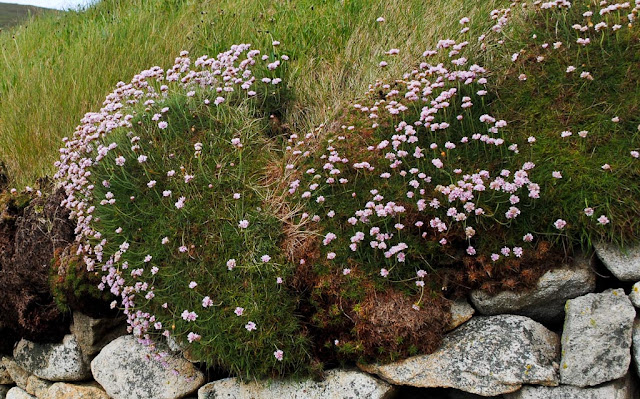Leaving Barra we headed out into the North Atlantic, looking for the tiny now uninhabited Isle of St. Kilda. This was our most memorable stop on the entire cruise, and this our most memorable photograph. St. Kilda has been occupied for thousands of years, though often inaccessible for 6 long winter months. But the population dwindled to 36 and finally those remaining islanders voted to be evacuated in 1930.
Below Mrs. F.G. you can see the line of old stone houses ringing the bay. Now owned by the National Trust for Scotland, it is one of very few double World Heritage Sites on the planet, qualified for both its natural and cultural features.The Trust has restored five of the homes with a secure roof, so you can get a sense of how the village may have looked with its very solid but tiny stone homes. This 'street' was where the men of the village met each morning to decide on the plan for the day, based on the season and the weather. Collecting eggs from the cliffs was the biggest and most dangerous work.
You could look inside these, and archeologists were working in one. It was a simple life, in mostly one-room homes, based on a communal way of living.
We climbed up toward the hills enough to get a view back down over the village. The stone enclosures were really exclosure, designed to keep the sheep that roamed freely over the island out of the potatoes and barley, and the graveyard. High on the opposite slope is a scar on the cliff, an ancient Neolithic quarry, probably for making stone tools 5000 years ago.
I was checking out the cleits after I saw a small bird darting around. There was a lot of this 'Thrift' growing on the rooftops too.
This is the distinctive St. Kilda Wren, a subspecies of the Eurasian Wren, endemic to only these islands. I was thrilled to spot it, the only place in the world it can be seen.
And we were both fascinated by the chance to see St. Kilda for ourselves. We were told that we'd been lucky with weather, it was a beautiful day and the seas were calm, enabling our ship to offload its passengers by dinghy. We were one of only two of five ships able to discharge passengers so far that year.









Fascinating place. It must have been a hard life and, realizing they went down over those cliffs on the ropes of the day, it makes you wonder how many fell to their deaths. Have you seen this old film -- https://www.youtube.com/watch?v=3cbWI_n04cA
ReplyDeleteWhat a wonderful adventure! It was a simpler time, for sure, but life looked like it was quite pleasant, at least when the weather was good. Glad you were able to see this place and share it with me. :-)
ReplyDeleteSo nice to see your beautiful photos from Scotland.
ReplyDeleteFabulous shots. I can't imagine living the way they did.
ReplyDeleteAmazing how people adapt to the landscape and survive! Love this post!
ReplyDeleteWhat an incredible place. In good weather, it would have been a peaceful existence, but I imagine the winters were very hard.
ReplyDeleteThat little wren is so sweet - I'm glad you were able to spot one. Thanks for sharing!
Fascinating site but it speaks of a bleak existence.
ReplyDeleteI really enjoyed this adventure! Goodness knows we won't get there!
ReplyDeleteI like all the old stone buildings and walls.
ReplyDeleteI felt sure I'd commented on this lovely post ...
ReplyDeleteDid my comment go into spam folder ... I wonder ...
All the best Jan